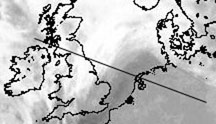 J. Brit. Astron. Assoc., 108, 2, 1998, p.64
J. Brit. Astron. Assoc., 108, 2, 1998, p.64
 J. Brit. Astron. Assoc., 108, 2, 1998, p.64
J. Brit. Astron. Assoc., 108, 2, 1998, p.64
 The estimated actual track of the stellar occultation by 790 Pretoria, plotted on an extract of the Meteosat image for NW Europe taken about 2 hours before the event. R. Miles
The estimated actual track of the stellar occultation by 790 Pretoria, plotted on an extract of the Meteosat image for NW Europe taken about 2 hours before the event. R. Miles
A positive occultation of a star by the asteroid 790 Pretoria on 1998 February 14 has been reported by Herr Udo Borcheld. The duration was predicted to be 8.1 sec maximum. Herr Borcheld found from his location at Detmold in NW Germany (Long. 8°53´36"E, Lat. 51°56´25"N) that the event lasted 6.3 sec. I estimate the location to be at 200m above sea level.
I have analysed the track assuming that Detmold lay near the centre of the shadow track. It appears that the actual track was shifted about one asteroid width northwards of the prediction. The event could have been seen from the north of Holland and the northwest of Germany (see map) - all other locations were clouded out including the UK. If it had been clear the track would have passed from Scarborough - Middlesborough - Carlisle - Dumfries - Ayr - Arran.
This is an example of the improvement in the accuracy of predictions that we can expect in future. A new and very useful WWW site has been set up at: http://sorry.vse.cz/~ludek/mp/1998/ where you can find the latest updates for 1998 events using updated orbits, where available, and Hipparcos and Tycho star data. Image files are included for each event. Predictions for events expected to be visible from the UK are also printed in the BAA Circulars, and uploaded to the BAA Web page at http://www.ast.cam.ac.uk/~baa/occ.html.
Provided that the weather is clear then for a medium-sized asteroid the chance of seeing an event if you are located on the predicted track is probably now about 30-50% or so on average - much better than any lottery!
Richard Miles
1 Tall Trees Close, Northwich, Cheshire CW8 4YA. [rmiles@baa.u-net.com]
Return to Journal 1998 April contents page